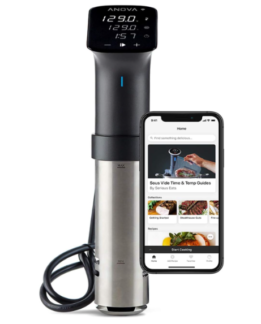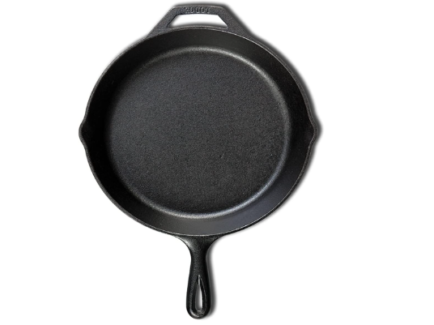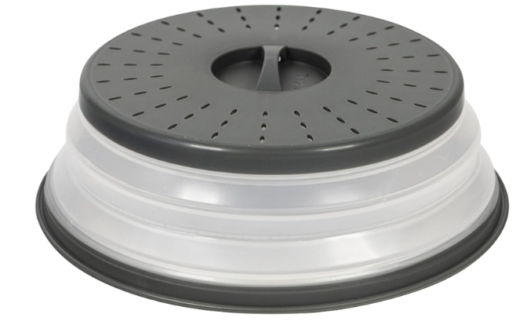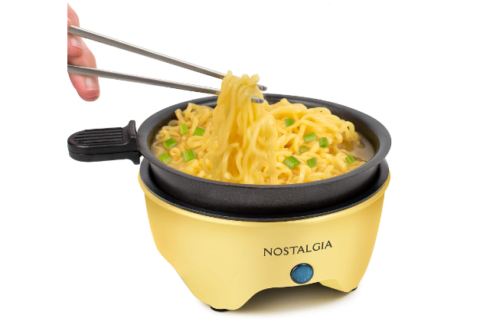The fast and easy way to bake frozen, homemade, take-and-bake,...
Read MoreIndoor pizza ovens are compact and specialized appliances designed for convenient pizza preparation in the comfort of your home. These ovens are crafted to replicate the high temperatures of traditional wood-fired pizza ovens, allowing you to achieve authentic, crispy, and evenly cooked pizzas.
Indoor pizza ovens come in various styles, including electric, gas, and countertop models, offering flexibility to fit different kitchen setups. With a focus on convenience and efficiency, these ovens enable pizza enthusiasts to enjoy homemade pizzas with customized toppings and flavors without the need for an outdoor setup.
Indoor pizza ovens have gained popularity for bringing the joy of pizza-making into the kitchen, providing a fun and delicious culinary experience for families and individuals alike.
Our Top Picks
Are indoor pizza ovens safe?
Indoor pizza ovens can be safe when used properly and in accordance with the manufacturer’s guidelines. Here are some key considerations to ensure the safe use of indoor pizza ovens:
- Follow Manufacturer’s Instructions: Always read and follow the instructions provided by the manufacturer. This includes guidelines on installation, operation, cleaning, and maintenance.
- Proper Ventilation: Adequate ventilation is crucial when using any indoor cooking appliance, including pizza ovens. Ensure that the kitchen area is well-ventilated to allow for the proper release of heat, steam, and any cooking odors.
- Keep Flammable Materials Away: Keep flammable materials, such as kitchen towels, paper, or curtains, away from the pizza oven during operation. This helps prevent fire hazards.
- Supervision: Do not leave the indoor pizza oven unattended while it is in use. Stay in the kitchen and monitor the cooking process to address any issues promptly.
- Use on Stable Surfaces: Place the pizza oven on a stable and heat-resistant surface. Avoid using it on surfaces that could be damaged by heat or that are not level.
- Keep Children and Pets Away: Ensure that children and pets are kept at a safe distance from the pizza oven, especially when it is in use and hot.
- Use Proper Utensils: Use appropriate utensils to handle hot surfaces and remove pizzas from the oven. Oven mitts or heat-resistant gloves are essential for handling hot items safely.
- Regular Maintenance: Keep the pizza oven clean and well-maintained. Follow the recommended cleaning procedures to prevent the buildup of grease and debris, which can pose a fire risk.
- Choose the Right Location: If your indoor pizza oven is a countertop model, ensure that it is placed on a heat-resistant surface away from other appliances and materials that could be affected by the heat.
It’s important to note that the safety features and guidelines can vary among different models and brands of indoor pizza ovens. Always refer to the specific instructions provided by the manufacturer to ensure safe operation. If you have any concerns or questions about the safety of your indoor pizza oven, contact the manufacturer or a qualified professional for guidance.
How do you vent an indoor pizza oven?
Venting an indoor pizza oven is crucial to ensure proper airflow, release of heat, and removal of cooking byproducts. Here are general guidelines for venting an indoor pizza oven:
- Hood Ventilation System: Most indoor pizza ovens should be used with a hood ventilation system or an overhead range hood. This system helps capture and remove heat, steam, and cooking odors from the kitchen. Ensure that the hood is appropriately sized for the oven and meets local building codes.
- Positioning the Oven: Place the pizza oven in a location where it can be easily connected to the existing ventilation system. The oven should be positioned beneath or near the range hood to allow for effective venting.
- Ductwork: Install ductwork to connect the pizza oven to the ventilation system. The ductwork should route the exhaust air and cooking byproducts outdoors. It’s important to follow local building codes and regulations when designing and installing ductwork.
- Hood Size and Capture Area: Choose a range hood with an adequate size and capture area to effectively handle the heat and emissions produced by the pizza oven. The hood should cover the entire cooking surface of the oven.
- Fan Speed and CFM Rating: Ensure that the range hood has sufficient fan speed and a cubic feet per minute (CFM) rating to handle the heat and cooking byproducts produced by the pizza oven. The CFM rating should comply with local building codes.
- Makeup Air: When using a powerful range hood, consider providing makeup air to compensate for the air being exhausted. This prevents negative pressure in the kitchen, which can affect the performance of the ventilation system.
- Professional Installation: Venting an indoor pizza oven may involve complex ductwork and ventilation system integration. It’s recommended to consult with a professional HVAC technician or a qualified installer experienced in kitchen ventilation systems to ensure proper installation.
- Follow Manufacturer’s Guidelines: Always follow the manufacturer’s guidelines and specifications for venting the specific model of pizza oven you have. Different ovens may have varying requirements, and adhering to the manufacturer’s recommendations is essential for safety and performance.
Proper ventilation is critical not only for safety but also for the efficient operation of your indoor pizza oven. If you’re unsure about the ventilation requirements or if you encounter challenges during installation, seeking professional assistance is advisable. Additionally, local building codes and regulations should be followed to ensure compliance with safety standards.
Where is the best place to put an indoor pizza oven?
The placement of an indoor pizza oven depends on various factors, including the type of pizza oven, available space, and safety considerations. Here are some general guidelines to help you determine the best place to put an indoor pizza oven:
- Ventilation System: Position the pizza oven in a location where it can be easily connected to a ventilation system. Most indoor pizza ovens require proper ventilation to remove heat, steam, and cooking odors from the kitchen. Place the oven beneath or near an overhead range hood with adequate CFM (cubic feet per minute) capacity.
- Proximity to Kitchen Hood: If you have a kitchen hood or an exhaust system, place the pizza oven within proximity to ensure efficient venting. This helps capture and remove cooking byproducts effectively.
- Heat Resistance: Choose a location with heat-resistant surfaces, especially if you have a countertop pizza oven. Avoid placing the oven on surfaces that could be damaged by heat, and ensure the area is well-ventilated to dissipate heat.
- Safety Clearance: Maintain proper safety clearance around the pizza oven. Keep flammable materials, such as curtains, towels, and paper, away from the oven to prevent fire hazards. Follow the manufacturer’s recommendations for clearance distances.
- Accessibility: Consider the accessibility of the pizza oven for both cooking and maintenance. Ensure there is enough space for loading and unloading pizzas, and that you can easily reach the oven controls.
- Aesthetic Considerations: Place the pizza oven in a location that complements the overall kitchen design and layout. Consider factors such as convenience, visibility, and how the oven fits into the aesthetic of the space.
- Electrical Outlet: Ensure there is a nearby electrical outlet for electric pizza ovens. If the oven requires a gas connection, make sure it is located near a gas line.
- Proximity to Dining Area: If you enjoy entertaining guests, consider placing the pizza oven in a location that is accessible to the dining area. This allows you to interact with guests while preparing pizzas.
- Professional Installation: For built-in or more complex installations, consult with a professional installer or contractor who has experience with indoor pizza ovens. They can ensure proper placement and integration with ventilation systems.
Remember to refer to the specific guidelines provided by the manufacturer of your pizza oven for installation recommendations. Additionally, adhere to local building codes and regulations to ensure safety and compliance with standards.
What is the best size indoor pizza oven?
The best size for an indoor pizza oven depends on your personal preferences, available space, and the number of people you typically cook for. Indoor pizza ovens come in various sizes, and the right size for you will be influenced by factors such as the oven’s cooking capacity, the size of pizzas you want to make, and the space you have in your kitchen. Here are some considerations:
- Cooking Capacity: Consider the number of pizzas you want to be able to cook at once. Larger ovens typically have a greater cooking capacity, allowing you to prepare multiple pizzas simultaneously.
- Size of Pizzas: If you prefer making larger pizzas or if you frequently entertain guests, a larger oven may be more suitable. Smaller ovens are adequate for personal use or smaller gatherings.
- Available Space: Measure the space where you plan to install the pizza oven to ensure it fits comfortably. Consider both the footprint of the oven and any clearance requirements recommended by the manufacturer.
- Countertop vs. Built-In: If you have limited space, a countertop pizza oven might be a more practical option. Built-in models may require additional space and planning but can offer a seamless integration with your kitchen design.
- Portability: Some indoor pizza ovens are designed to be portable, allowing you to move them around as needed. This can be beneficial if you want flexibility in where you use the oven.
- Type of Oven: Different types of indoor pizza ovens, such as electric, gas, or wood-fired models, may come in varying sizes. Consider the type of oven that best suits your preferences and cooking style.
- Installation Considerations: If you’re planning a built-in installation, consider the available space in your kitchen for the oven and any additional features you might want, such as a ventilation hood.
Common sizes for indoor pizza ovens include compact countertop models with a cooking surface of around 12 to 16 inches, and larger built-in models with cooking surfaces ranging from 16 inches up to 30 inches or more.
Before making a purchase, it’s advisable to carefully read the product specifications, including the cooking surface dimensions and overall size. Additionally, check customer reviews to gain insights into the performance and usability of the specific model you’re considering.
Benefits of using indoor pizza oven
Using an indoor pizza oven can offer several benefits, enhancing your cooking experience and allowing you to enjoy delicious homemade pizzas. Here are some advantages of using an indoor pizza oven:
- Convenience: Indoor pizza ovens provide a convenient way to make pizzas in the comfort of your home. You can enjoy the process of crafting and baking pizzas without the need for an outdoor setup.
- Authentic Pizza Taste: High-quality indoor pizza ovens are designed to replicate the high temperatures of traditional wood-fired ovens. This allows you to achieve an authentic, crispy crust and evenly cooked pizza, similar to those from pizzerias.
- Versatility: Many indoor pizza ovens are versatile and can be used for more than just pizza. Some models can cook a variety of dishes, including bread, roasted vegetables, and even desserts, expanding your culinary options.
- Quick Cooking Time: Indoor pizza ovens typically reach high temperatures quickly, resulting in shorter cooking times. This is advantageous when you want to prepare a meal in a relatively short period.
- Customization: With an indoor pizza oven, you have full control over the ingredients and toppings, allowing you to customize pizzas to suit your taste preferences or accommodate dietary restrictions.
- Year-Round Use: Unlike outdoor pizza ovens that may be limited to fair weather, indoor pizza ovens can be used year-round, providing a consistent and reliable cooking environment regardless of the weather conditions.
- Entertaining Guests: Indoor pizza ovens can be a focal point during social gatherings. You can entertain guests by involving them in the pizza-making process or by serving freshly baked pizzas, making it a fun and interactive experience.
- Space Efficiency: Countertop or compact indoor pizza ovens are designed to fit in smaller spaces, making them suitable for kitchens with limited room. Built-in models can be seamlessly integrated into kitchen designs.
- Energy Efficiency: Many indoor pizza ovens, especially electric models, are energy-efficient, requiring less time to preheat and cook compared to traditional ovens. This can contribute to energy savings over time.
- Easy to Clean: Indoor pizza ovens are often designed with ease of cleaning in mind. Removable components and non-stick surfaces simplify the cleaning process after each use.
- Great for Pizza Enthusiasts: For individuals passionate about pizza-making, having an indoor pizza oven allows for regular experimentation with different crusts, sauces, and toppings, honing your pizza-making skills.
Before purchasing an indoor pizza oven, consider your specific needs, available space, and the features offered by different models. Reading product reviews and understanding the capabilities of the oven will help you make an informed decision based on your preferences.
Related Posts
Are indoor pizza ovens safe?
Indoor pizza ovens are compact and specialized appliances designed for...
Read MoreHow to clean outdoor pizza oven
Cleaning your outdoor pizza oven is an essential part of...
Read MoreWhy Trust Us
You will find what you are looking for at Jody's Bakery. From classic to luxury brands, you'll find both. We will help you to select appliances that fit your needs, budget and lifestyle. Whether you want to stop by to learn more — or plan to make a major purchase — we’ll treat you like family and assist you every step of the way. Shop with us today to receive friendly and experienced help along the way.





















… [Trackback]
[…] Read More Information here to that Topic: jodysbakery.com/are-indoor-pizza-ovens-safe/ […]
… [Trackback]
[…] There you will find 78255 additional Info on that Topic: jodysbakery.com/are-indoor-pizza-ovens-safe/ […]
… [Trackback]
[…] Read More on on that Topic: jodysbakery.com/are-indoor-pizza-ovens-safe/ […]
… [Trackback]
[…] Find More on on that Topic: jodysbakery.com/are-indoor-pizza-ovens-safe/ […]
… [Trackback]
[…] Read More to that Topic: jodysbakery.com/are-indoor-pizza-ovens-safe/ […]
… [Trackback]
[…] Here you can find 32739 more Information to that Topic: jodysbakery.com/are-indoor-pizza-ovens-safe/ […]
… [Trackback]
[…] Find More Info here to that Topic: jodysbakery.com/are-indoor-pizza-ovens-safe/ […]
… [Trackback]
[…] Information to that Topic: jodysbakery.com/are-indoor-pizza-ovens-safe/ […]
… [Trackback]
[…] Here you can find 11161 more Information to that Topic: jodysbakery.com/are-indoor-pizza-ovens-safe/ […]
… [Trackback]
[…] There you will find 79517 more Info on that Topic: jodysbakery.com/are-indoor-pizza-ovens-safe/ […]
… [Trackback]
[…] Information on that Topic: jodysbakery.com/are-indoor-pizza-ovens-safe/ […]